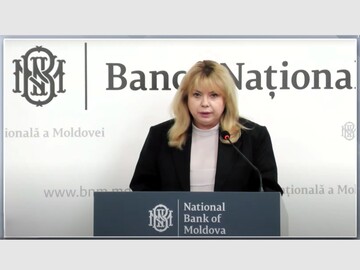
The National Bank maintained its average annual inflation forecast for 2025 at 7.7%, but raised its forecast for 2026 from 3.9% to 4.3% (+0.4 percentage points)
National Bank of Moldova President Anca Dragu announced this at a press conference on November 13, presenting the fourth Inflation Review of the year. She outlined the main economic trends of the year, noting that the annual inflation rate had decreased from 8.2% in June 2025 to 6.9% in September, indicating a slowdown in inflation. To consolidate this trend, the NBM adopted a series of monetary policy measures aimed at maintaining a balanced inflation climate. "This year, the National Bank acted in a measured and cautious manner, maintaining the downward trajectory of inflation. In September, the indicator fell to 6.9%, and forecasts indicate a continuation of this trend. “Starting next year, we expect inflation to return to the target corridor – below 6.5%,” said Anca Dragu. According to the NBM forecasts, annual inflation will continue to decline in 2025 and in the first half of 2026. Inflation is expected to return to the target range as early as Q1 2026 and remain within it until the end of the forecast period. According to NBM estimates, annual inflation will peak at 6.7% in Q4 2025 and subsequently decline to a minimum of 4.1% in Q2 2026. The dynamics of the annual inflation rate throughout the forecast period will be mainly positively determined by changes in food prices, core inflation and administered prices, and to a lesser extent – by fuel prices, starting from Q1 2027. At the same time, fuel prices will have a negative impact on the annual inflation rate until Q4 2026. For 2025, the National Bank forecasts average annual inflation of 7.7%, falling to 4.3% in 2026. However, the NBM notes that significant risks remain that could impact the forecast, related to geopolitical events and possible adjustments to regulated tariffs. "Although global trade and geopolitical tensions have eased somewhat recently, uncertainty remains. The consequences of the economic barriers imposed by the US presidential administration will become apparent in the near future. The restructuring of global supply chains and slowing investment are expected to negatively impact global economic growth. Ongoing negotiations between the US and China will shape economic relations between the world's largest economies. The economic recovery in the eurozone will be slow. The lack of progress in negotiations to end the war in Ukraine has led the UK and the US to impose sanctions against the Russian oil industry. This was followed by the 19th package of economic sanctions imposed by the European Commission. Herewith, OPEC+ countries have significantly increased oil production over the past year. These events, as well as the de-escalation of the situation in the Middle East, will continue to determine oil prices. Natural gas prices in Europe are expected to decline moderately in the medium term due to robust global supply, while global food prices will balance out by the end of the forecast period," the National Bank notes. Economic growth in the eurozone is expected to be weak: 1.3% in 2025 and 1% in 2026, with inflation at 2.1% and 1.7%, respectively. The euro-dollar exchange rate is projected at 1.13 in 2025 and 1.18 in 2026. The price of Brent crude oil is expected to fall to $68.7 per barrel in 2025 and to $61.8 in 2026. Natural gas on world markets will fall in price to $382.96 per 1,000 cubic meters in 2025 and to $321.8 per 1,000 cubic meters in 2026. International food prices, after a 2.1% decline in 2024, will grow by 4.9% in 2025, but by 2026 the growth will be more moderate - by 1.9%. From the real sector, there is uncertainty regarding the timing and scale of the adjustment of regulated tariffs, the volume of agricultural production next year and the volume and procedure for providing and reflecting compensation for energy resources in this heating season. Weather conditions determine the vulnerability of local agricultural prices, and a decline in consumer demand due to the outflow of refugees to Ukraine and other countries could pose deflationary risks. An increase in external loans and grants is expected in 2026, which will facilitate the implementation of reforms and stimulate economic activity. However, this will also lead to an increase in excess liquidity in the banking system, which in the short term will have a positive impact on aggregate demand and increase inflationary pressure. Inflation could be driven by a strengthening of the national currency—in both nominal and real terms, this stimulates imports but could negatively impact Moldova's net exports. Combined with rising global prices for goods and services, this will lead to a deterioration in the trade balance and increase pressure on the depreciation of the Moldovan leu. The Governor of the National Bank assured that the regulator will continue to closely monitor domestic and external macroeconomic trends, as well as risks that could affect the inflation trajectory in the short and medium term.// 13.11.2025 – InfoMarket.







